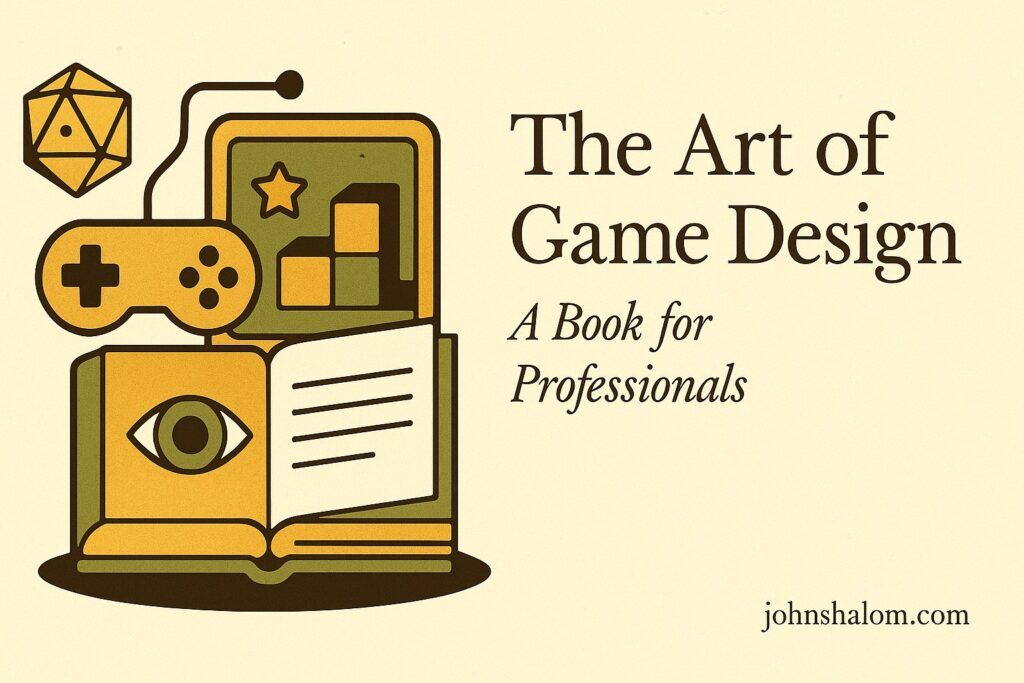
TL;DR:
Game design isn’t about pixels—it’s about people. The Art of Game Design taught me that every great game starts with empathy, creativity, and curiosity. It’s not the graphics that make players stay—it’s the emotions they feel. When design meets purpose, games stop being products and start becoming experiences.
As a passionate game designer, I’ve always been on the lookout for resources that can enhance my skills and broaden my understanding of the craft. One book that has had a profound impact on my journey is “The Art of Game Design: A Book for Professionals” by Jesse Schell.
This comprehensive guide delves deep into the principles and techniques of game design, offering invaluable insights for both beginners and seasoned professionals. In this article, I’ll share my personal experiences with the book and highlight key concepts that have shaped my approach to game design.
FAQs: The Art of Game Design: A Book for Professionals
1. What is The Art of Game Design about?
It’s a guide by Jesse Schell that explores the creative and psychological principles behind designing memorable games.
2. Who should read this book?
Game designers, developers, and storytellers who want to create games that entertain, teach, and inspire deeper engagement.
3. What makes this book different from technical game guides?
It focuses on the why of design—player experience, motivation, and emotion—rather than just coding or mechanics.
4. Can beginners benefit from this book?
Yes. While written for professionals, its insights on creativity, design thinking, and storytelling are valuable for all levels.
5. What’s the key takeaway from The Art of Game Design?
That great games balance art, psychology, and play—reminding us that design is not just logic; it’s empathy in action.
My Introduction to “The Art of Game Design”
I first came across “The Art of Game Design” during a game development conference. A fellow designer highly recommended it, describing it as a must-read for anyone serious about creating engaging and meaningful games. Intrigued, I decided to give it a try. From the very first chapter, I was hooked. Schell’s conversational writing style and practical approach made complex concepts accessible and easy to grasp. The book quickly became my go-to reference for all things game design.
The Lenses of Game Design
One of the most compelling aspects of “The Art of Game Design” is the concept of lenses. Schell introduces over 100 lenses, each representing a different perspective or question to consider when designing a game. These lenses serve as valuable tools for evaluating and refining game ideas. Here are a few lenses that have been particularly influential in my work:
The Lens of Fun
At the heart of every great game is the element of fun. The Lens of Fun encourages designers to ask, “What is fun about my game?” and “How can I make it more fun?” This lens has reminded me to always prioritize the player’s enjoyment and to iterate on my designs to maximize the fun factor.
The Lens of Curiosity
Curiosity is a powerful motivator that drives players to explore and engage with a game. The Lens of Curiosity prompts designers to think about how they can spark players’ curiosity and keep them intrigued. By incorporating elements of mystery, surprise, and discovery, I’ve been able to create more engaging and immersive experiences.
The Lens of Feedback
Feedback is crucial for helping players understand the impact of their actions and guiding them toward their goals. The Lens of Feedback encourages designers to consider the clarity, frequency, and effectiveness of the feedback provided in their games. This lens has taught me the importance of clear and timely feedback in enhancing the player’s experience and maintaining their engagement.
The Lens of Goals
Clear and meaningful goals give players a sense of purpose and direction. The Lens of Goals asks, “What are the goals of my game?” and “Are they clear and motivating for the player?” This lens has helped me design goals that are challenging yet achievable, providing players with a sense of accomplishment and progression.

The Elements of Game Design
Schell breaks down game design into several key elements, each of which plays a critical role in creating a cohesive and enjoyable experience. Understanding and mastering these elements has been instrumental in my growth as a designer.
Mechanics
Mechanics are the rules and systems that define how a game operates. They determine what players can and cannot do, as well as how the game responds to their actions. Schell emphasizes the importance of balancing mechanics to ensure a fair and enjoyable experience. Through careful iteration and playtesting, I’ve learned to fine-tune mechanics to create engaging and challenging gameplay.
Story
A compelling story can elevate a game from a series of tasks to a meaningful and immersive experience. Schell discusses the role of narrative in games and offers practical advice for crafting engaging stories. By integrating story elements that resonate with players and complement the gameplay, I’ve been able to create more emotionally impactful games.
Aesthetics
Aesthetics encompass the visual, auditory, and tactile aspects of a game. They contribute to the overall atmosphere and mood, shaping the player’s sensory experience. Schell encourages designers to think about how aesthetics can enhance the game’s themes and emotions. I’ve found that paying attention to details like art style, sound design, and user interface can significantly elevate the quality of a game.
Technology
Technology is the foundation that supports and enables the other elements of a game. Schell highlights the importance of choosing the right tools and platforms for a project. Staying updated with the latest technological advancements has allowed me to leverage new features and capabilities in my designs.

Iterative Design Process
“The Art of Game Design” emphasizes the importance of iteration in the design process. Schell advocates for a cycle of prototyping, playtesting, and refining to continuously improve a game. This iterative approach has become a cornerstone of my design philosophy.
Prototyping
Prototyping involves creating early versions of a game to test ideas and concepts. Schell encourages designers to prototype quickly and cheaply, allowing them to explore multiple ideas without committing significant resources. I’ve embraced this mindset, using paper prototypes and simple digital versions to experiment with different mechanics and gameplay elements.
Playtesting
Playtesting is the process of observing players as they interact with a prototype. It provides valuable insights into how players perceive and experience the game. Schell stresses the importance of gathering feedback from diverse players and being open to criticism. Through playtesting, I’ve identified and addressed issues that I might have overlooked, resulting in more polished and enjoyable games.
Refining
Refining involves making adjustments based on feedback and playtesting results. Schell highlights the importance of being flexible and willing to iterate on designs. This stage is about fine-tuning mechanics, balancing difficulty, and enhancing the overall experience. By embracing refinement as a continuous process, I’ve been able to create games that are well-rounded and engaging.
The Role of Empathy in Game Design
One of the key takeaways from “The Art of Game Design” is the importance of empathy. Understanding and empathizing with players allows designers to create experiences that resonate on a deeper level. Schell encourages designers to put themselves in the player’s shoes and consider their emotions, motivations, and challenges.
Player-Centric Design
Player-centric design is about prioritizing the needs and preferences of the players. Schell discusses techniques for gaining insights into player behavior, such as conducting surveys, interviews, and observing gameplay. By adopting a player-centric approach, I’ve been able to create games that cater to the desires and expectations of my audience.
Emotional Engagement
Emotional engagement is a crucial aspect of creating memorable gaming experiences. Schell explores the various ways games can evoke emotions, from joy and excitement to tension and empathy. By incorporating emotional elements into my designs, I’ve been able to create more impactful and meaningful experiences for players.
You might also like: Essential Computer Skills for the 21st Century: From Basics to Advanced Tips
Conclusion
“The Art of Game Design: A Book for Professionals” has been an invaluable resource in my journey as a game designer. Jesse Schell’s insights and practical advice have deepened my understanding of the craft and inspired me to strive for excellence in my work. From the lenses of game design to the iterative design process, the concepts in this book have shaped my approach to creating engaging and enjoyable games. I highly recommend this book to anyone passionate about game design, whether you’re just starting out or looking to refine your skills. Embrace the art of game design, and let your creativity and empathy guide you in crafting unforgettable gaming experiences.


